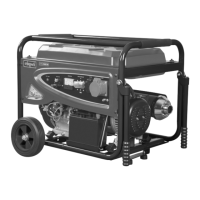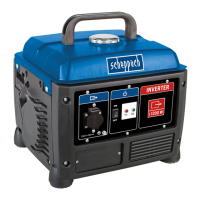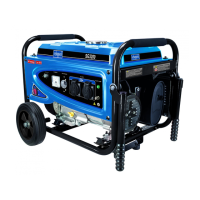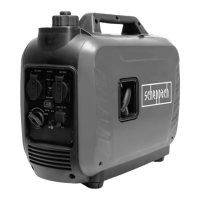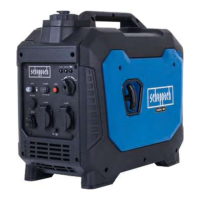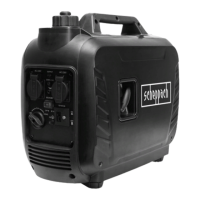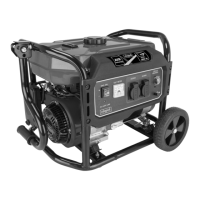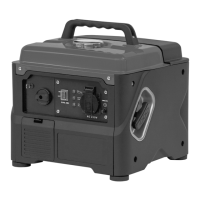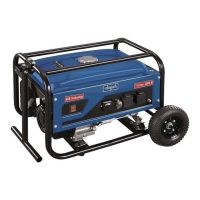www.scheppach.com
GB
|
31
Clean the air lter (19) every 50 operating hours, re-
place if necessary.
1. Remove the engine cover (3) (Fig. 7).
2. Remove the wing screw (17) (Fig. 9).
3. Unfold the air lter cover (18).
4. Remove the air lter (19).
5. Do not use harsh cleaners or petrol to clean the
lter.
6. Clean the elements by knocking them out on a at
surface. If heavily soiled, wash with soapy water,
then rinse with clean water and allow to air dry.
7. The re-assembly takes place in reverse order.
10.6 Spark plug (Fig. 11 + 12)
m ATTENTION: Only replace the spark plug when
the engine is cold!
Check the spark plug (20) for contamination for the rst
time after 20 operating hours and clean it with a copper
wire brush if necessary. Then maintain the spark plug
(20) every 50 operating hours.
1. Open the spark plug cover (4).
2. Pull o the spark plug connector (21) with a twist-
ing motion.
3. Remove the spark plug (20) with the enclosed
spark plug wrench (15).
4. Remove any dirt from the base of the spark plug
(20).
5. Visually inspect the spark plug (20). Remove any
deposits present using a wire brush.
6. Check the spark plug gap. Set the electrode gap to
0.6 to 0.7 mm with a feeler gauge.
7. The re-assembly takes place in reverse order.
NOTE
A loose spark plug can overheat and cause damage
to the engine. Tightening the spark plug too much can
damage the thread in the cylinder head.
10.7 Clean the fuel lter insert (Fig. 13 + 14)
Note: The fuel lter insert (22) is a lter cup which is
located directly under the tank cover (2) and lters all
the fuel lled in.
1. Set the on/o switch (13) to the “OFF” position.
2. Open the tank cover (2).
3. Remove the fuel lter insert (22) and the ll level
marking (23). Clean it in a non-ammable solvent
or a solvent with a high ash point.
4. Reinsert the fuel lter insert (22) with the ll level
marking (23).
5. Close the tank cover (2).
ATTENTION! Danger of burning! Wait until the de-
vice has cooled down before performing cleaning or
maintenance work.
10.1 Cleaning
Keep protective devices, air vents and the motor hous-
ing as free of dust and dirt as possible. Rub the device
clean with a clean cloth or blow it o with compressed
air at low pressure. We recommend that you clean the
device directly after every use.
Clean the device at regular intervals using a damp
cloth and a little soft soap. Do not use any cleaning
products or solvents; they could attack the plastic parts
of the device. Make sure that no water can penetrate
the device interior.
10.2 Maintenance
WARNING!
Always wear protective gloves and a mask during
maintenance work!
10.3 Check the oil level (g. 7 + 8)
1. Proceed as described under 8.1.
10.4 Oil change
Change the engine oil after 20 operating hours, then
after 50 hours or every three months.
The engine oil change should be carried out while the
engine is at operating temperature.
1. Place the power generator on a level, even surface.
2. Remove the engine cover (3) as described in 9.1.
(Fig. 7)
3. Provide a collection container (not included in the
scope of delivery).
4. Open the oil dipstick (16) and drain warm engine
oil into the collection container by tilting the power
generator.
5. Fill up with new engine oil (approx. 0.35 l).
6. Screw the oil dipstick (16) in again.
7. Dispose of the used oil properly.
10.5 Air lter (Fig. 10)
NOTE!
Risk of damage!
Operating the engine without a lter element or with
a damaged lter element can cause engine damage.
- Never run the engine without the air lter element or
with a damaged lter element. This would allow dirt
into the engine, which would result in severe dam-
age to the engine.
